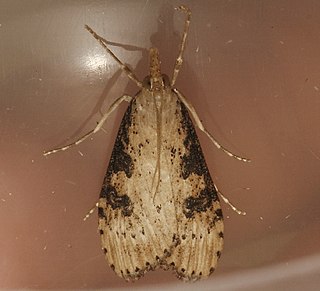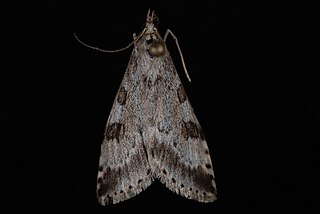
Udea prunalis is a moth of the family Crambidae. It is found in Europe and China. The species was first described by Matthew Denis and Ignaz Schiffermüller in 1775. In the Butterfly Conservation's Microlepidoptera Report 2011 this species was classified as common in the UK.

Udea is a genus of snout moths in the subfamily Spilomelinae of the family Crambidae. The genus was erected by Achille Guenée in 1845. The currently known 216 species are present on all continents except Antarctica. About 41 species are native to Hawaii.

Aseptis fumosa is a moth of the family Noctuidae first described by Augustus Radcliffe Grote in 1879. It is widespread in western North America and is known from western Canada, Washington, Nebraska, Colorado, Utah, Arizona, Nevada and California. It occurs in a variety of diverse habitats including coast chaparral, dry conifer forest, and shrub steppe.
Acroncosa albiflavella is a species of moth of the family Pyralidae, of the order Lepidoptera. Acroncosa albiflavella was described by William Barnes and James Halliday McDunnough in 1917. It is found in western North America, including New Mexico and California.
Evergestis funalis is a moth in the family Crambidae. It was described by Augustus Radcliffe Grote in 1878. It is found in North America, where it has been recorded from Alaska, Arizona, British Columbia, California, Colorado, Nevada, Oregon, Utah and Washington.

Pyrausta lethalis, the lethal pyrausta moth, is a moth in the family Crambidae. It was described by Augustus Radcliffe Grote in 1881. It is found in North America, where it has been recorded from California to southern Nevada, southern Arizona and Texas.
Blepharomastix benetinctalis is a species of moth in the family Crambidae. It was described by Harrison Gray Dyar Jr. in 1914. It is found in Tabasco, Mexico.

Udea itysalis is a moth in the family Crambidae. It was described by Francis Walker in 1859. It is found in North America, where it has been recorded from British Columbia to Quebec, south to Colorado, California, Nevada and Arizona. It has also been recorded from the Sayan Mountains in Russia.
Udea abstrusa is a moth in the family Crambidae. It was described by Eugene G. Munroe in 1966. It is found in North America, where it has been recorded from Alberta, British Columbia, Colorado, New Mexico, the Northwest Territory, Washington and Wyoming.
Udea berberalis is a moth in the family Crambidae. It was described by William Barnes and James Halliday McDunnough in 1918. It is found in North America, where it has been recorded from California.
Udea beringialis is a moth in the family Crambidae. It was described by Eugene G. Munroe in 1966. It is found in North America, where it has been recorded from Alaska, Alberta, British Columbia, Manitoba and the Yukon Territory.
Udea brevipalpis is a moth in the family Crambidae. It was described by Eugene G. Munroe in 1966. It is found in North America, where it has been recorded from California, Colorado and Utah.
Udea cacuminicola is a moth in the family Crambidae. It was described by Eugene G. Munroe in 1966. It is found in North America, where it has been recorded from Colorado and Wyoming.
Udea derasa is a moth in the family Crambidae. It was described by Eugene G. Munroe in 1966. It is found in North America, where it has been recorded from British Columbia and Utah.
Udea indistinctalis is a moth in the family Crambidae. It was described by William Warren in 1892. It is found in North America, where it has been recorded from Alberta, Saskatchewan, Washington and California.

Udea livida is a moth in the family Crambidae. It was described by Eugene G. Munroe in 1966. It is found in North America, where it has been recorded from British Columbia, Washington and Utah.

Udea profundalis is a moth in the family Crambidae. It was described by Packard in 1873. It is found in North America, where it has been recorded from British Columbia, through Washington, Oregon and Nevada to California and Texas. Records east of the Rocky Mountains, refer to Udea rubigalis.
Udea rusticalis is a moth in the family Crambidae. It was described by William Barnes and James Halliday McDunnough in 1914. It is found in North America, where it has been recorded from Arizona.
Udea vacunalis is a moth in the family Crambidae. It was described by Augustus Radcliffe Grote in 1881. It is found in North America, where it has been recorded from California.

Udea washingtonalis, the Washington udea moth, is a moth in the family Crambidae. It was described by Augustus Radcliffe Grote in 1882. It is found in North America, where it has been recorded from Alaska, British Columbia, California, Montana and Washington.








